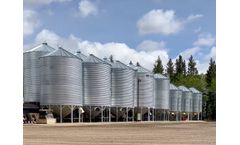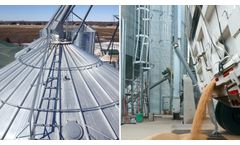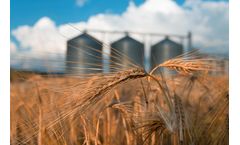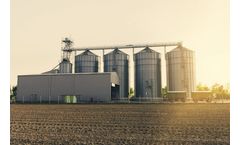Grained Soils Using Suction Measurements Articles & Analysis
20 articles found
The evolution of bin management systems has been marked by continuous innovation aimed at improving the efficiency, reliability, and profitability of farming operations. Traditional methods, which largely depended on manual labor for monitoring and managing stored grain, have gradually given way to more sophisticated, technology-driven solutions. These advancements, including automation, are ...
ABM’s non-contact level sensors are used in the Agriculture industry for monitoring silos, process tanks and storage containers. For this application, ABM’s non-contact ultrasonic sensors were used to continuously monitor grain level in silos. The sensors are self-cleaning, eliminating build-up on the transducer face for maintenance free operation. During filling conditions the ...
How to benefit from connected devices on your farm A growing number of farmers are using the internet of things (IoT) to save time, increase production and reduce costs. So, what is IoT and how can you benefit from using IoT solutions and connected devices in your ...
CO2 monitoring plays a vital role in the preservation of stored grains and cereals. In a recent article published by Process Industry Informer, it was highlighted that over 50% of stored grains are lost after harvesting due to spoilage caused by mould or insect infestation, and amounts to roughly $1 trillion per year in losses. However, these major economic losses can be combatted by the early ...
Meeting the food requirements of a growing global population is becoming increasingly difficult. Despite the need for additional food, it is estimated that 50-60% of grain is lost after harvesting, at a cost of about $1 trillion per year.1 One of the major reasons for lost grain is spoilage due to mould or insect infestation during storage.2 To provide a constant supply of grain year-round, after ...
Regardless of whether your yield data comes from your combine, grain cart, or from truck scales, each source has shortcomings that will not only influence your farm decisions but may also have a negative financial impact. This harvest growers will spend significant time and money chasing down accurate yield data from combine yield monitors, grain carts and/or truck scale tickets. Each of these ...
In Bowen, Queensland, in 2010, Hibrix was compared with a high NPK mineral fertiliser program for the production of maize cv. Hycorn 675IT on an alluvial sandy loam soil irrigated via sub-surface drip tape. At commercial harvest, cobs from 20 randomly selected plants per plot from were harvested, weighed and the length, girth at the cob base and length of tip not filled with kernels was measured. ...
Meeting the food requirements of a growing global population is becoming increasingly difficult. Despite the need for additional food, it is estimated that 50-60% of grain is lost after harvesting, at a cost of about $1 trillion per year.1 One of the major reasons for lost grain is spoilage due to mould or insect infestation during storage.2 To provide a constant supply of grain year-round, ...
Better grain storage would save money and feed over a billion, says Digvir S. Jayas. It deserves more attention. Annually over 2.6 billion tonnes of grains — cereals, oilseeds and pulses — are grown and then stored along the chain from producers to consumers. Most countries do not systematically report how much grain becomes unfit for human consumption during storage, but anecdotal ...
Improved wheat grains storage management SmartScan25 was installed at the Israeli large flour mill to improve wheat grains storage management, save costs and reduce material losses. Israeli Mills Ltd, located in the city of Tel Aviv, is one of the leading local flour providers. The mill produces various types of wheat products such as: bran, white flour, semolina and more, for local use. The ...
The xenia effect results from the cross-fertilization of nonrelated lines of crops, which causes a grain to produce a germ or embryo that is much larger than average. It is a significant genetic component in TopCross grain production systems, which can affect grain yield and quality. This study measured hormone variations during grain filling of normal corn (Zea mays L.) hybrids, and normal corn ...
Competition mechanisms among adjacent plants are not well understood. This study compared corn growth and yield responses to water, N, and shade at 74,500 plants ha–1 (1x) with responses to water and N when planted at 149,000 plant ha–1. Plant biomass, leaf area, chlorophyll content, reflectance, and enzyme expression (transcriptome analysis) were measured at V-12. Grain and stover yields were ...
Pearl millet [Pennisetum glaucum (L.) R. Br.] single cross hybrids, bred from high-yielding parental lines in favorable environments, are not well adapted to northwest India's arid zone. The objectives of these experiments were (i) to measure grain and stover yield heterosis in testcrosses of six landrace-based restorer populations and (ii) to understand how heterosis for biomass and harvest ...
Grain β-glucan content is the most important attribute for barley (Hordeum vulgare L.) varieties destined for the human food market. This trait is important because of the blood glucose and cholesterol-reducing properties of β-glucans. High levels of grain protein content, test weight, and seed size and endosperm color may also add value. Seed yield potential, in part, determines the ...
This study determined the influence of corn (Zea mays L.) hybrids, N availability, grain harvest moisture, and drying temperatures on dry-mill ethanol production. Six hybrids, ranging from 92 to 108 d in relative maturity (RM), were planted at two locations over 2 yr. One of four N fertilizer treatments were applied. Grain was hand-harvested at grain moistures of 20 and 25%. Grain was dried to ...
Information on the contribution of plant breeding to changes in yields and other agronomic traits is useful for optimizing selection gains; thus, this study aimed to determine the contribution of Texas rice (Oryza sativa L.) breeding to changes in cultivars released during the 48 yr since the release of ‘Bluebonnet’ in 1944. Twenty-three cultivars were evaluated in three environments and two N ...
The North China Plain (NCP) belongs to the major maize (Zea mays L.) growing areas in China. Maize yields have increased steadily since the 1980s, but in recent years average yields have stabilized around 5000 kg ha–1. The objective of this study was to quantify the production potential of summer and spring maize in the NCP. For this purpose the CERES-Maize model was calibrated and validated. The ...
Efficient management of P in crop production requires the development of tools to quantify the P status of plants. Our objectives were to establish the relationship between P and N concentrations of spring milling wheat (Triticum aestivum L.) during the growing season and, in particular, to determine the critical P concentration required to diagnose P deficiency. Shoot biomass and P and N ...
Remote sensing in the form of aerial color infrared (CIR) photography has been shown to be a useful tool for in-season N management in winter wheat (Triticum aestivum L.). The objectives of this study were (i) to develop a methodology for predicting in-season optimum fertilizer N rates for winter wheat at growth stage (GS) 30 directly from aerial CIR photography and (ii) to quantify how the ...
Hitherto employed swelling test methods are time consuming and not reliable. Testing methods based on suction potential measurements are being introduced in order to evaluate the expansive potential.Swelling test results on three fine-grained soils are described in the paper. Two testing systems were used: (1) a ...












